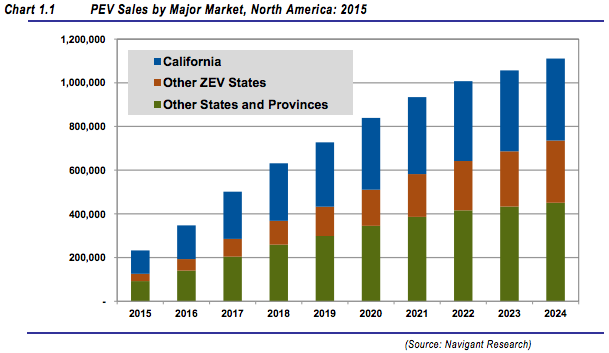Here’s Where Electric Vehicle Use Is Growing Among U.S. Cities

Matej Kastelic / Shutterstock.com
California leads the pack of states with zero emissions vehicle programs, but large car markets, incentives and well-developed infrastructures are also factors.
Rising plug-in electric vehicle (PEV) use in U.S. cities will drive local governments and utilities to regulate them, according to a new Navigant Research report.
More than 133,000 PEVs sold in 2014 in North America, the world’s strongest market, and in no state is demand higher than California.
Incentives and California’s mandatory Zero Emissions Vehicle (ZEV) Program mean sales numbers will continue to grow in the state’s largest cities, per the report:
Metropolitan areas in California are expected to witness the largest PEV population growth, as the Los Angeles, San Francisco, San Jose, and San Diego metro areas are all within the top 10 metro markets for PEV sales. Utilities serving these areas have been at the forefront of developing advanced demand-side management programs for residential PEV charging and vehicle-grid integration. Utilities and regulatory authorities in emerging PEV markets elsewhere in the United States and Canada will likely follow suit, creating new opportunities for energy aggregators and EVSE service providers.

PEVs account for 3 percent of California’s light duty vehicles, with that number expected to jump to 15 to 22 percent by 2024. The U.S.’s nine other ZEV states will see similar growth but nowhere close to the Golden State.
Outside of those states, only Hawaii, Washington and Georgia are expected to see similar growth in PEV use because of their large vehicle markets, incentives and well-developed infrastructure.
The U.S., North America’s largest market, is projected to see between 860,000 and 1.2 million PEVs sold in 2024.
“Automaker adoption of PEV technologies as adaptations for existing model lines is growing significantly, and these technologies are being placed into larger vehicle segments such as sport utility vehicles (SUVs), trucks, and minivans,” research analyst Scott Shepard said in a statement. “Similarly, the introduction of next-generation, fully electric vehicles with ranges near or over 200 miles and price points below $40,000 is expected to drastically increase mass-market PEV acceptance as a pragmatic transportation option.”
NEXT STORY: IPv4 addresses running out -- really






